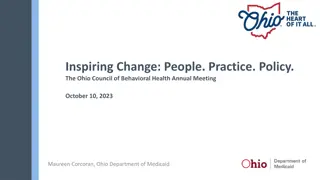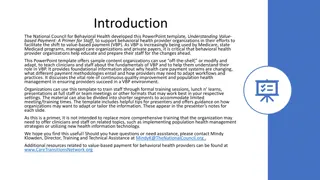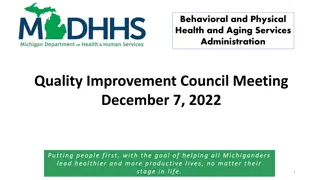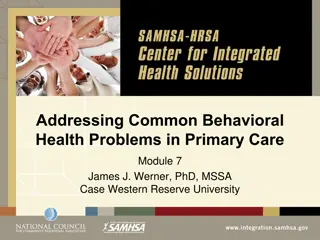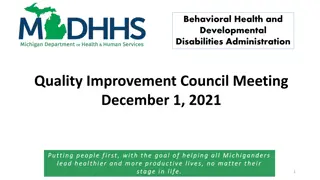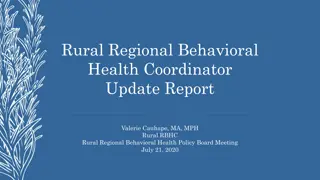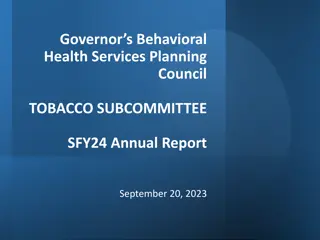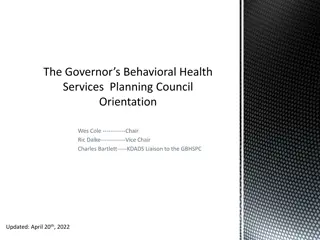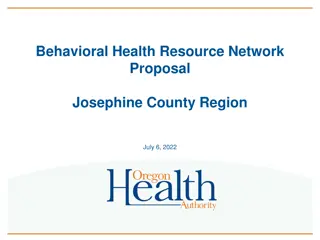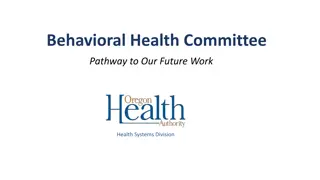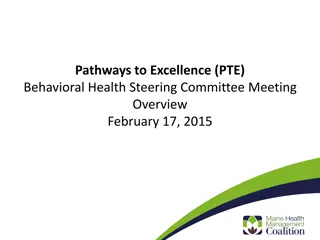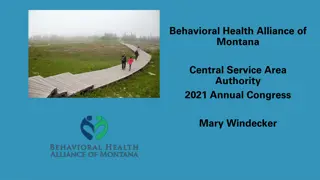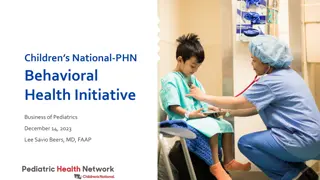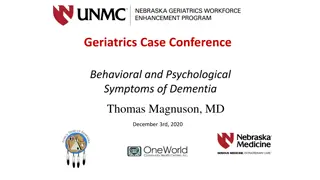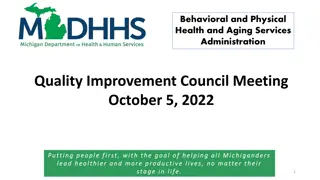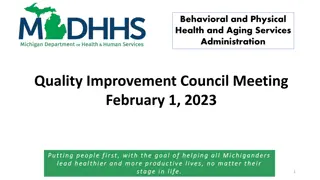Behavioral and Physical Health Council Meeting Highlights
The Behavioral and Physical Health Council meeting emphasized person-centered planning to help Michiganders lead healthier lives. Updates on organizational restructuring, evidence-based practices, and strategies to address racial/ethnic disparities were discussed. Performance metrics and quality efforts were highlighted to improve outcomes for beneficiaries. The meeting aimed to support individuals at all stages of life through collaborative efforts and promising practices.
Download Presentation

Please find below an Image/Link to download the presentation.
The content on the website is provided AS IS for your information and personal use only. It may not be sold, licensed, or shared on other websites without obtaining consent from the author. Download presentation by click this link. If you encounter any issues during the download, it is possible that the publisher has removed the file from their server.
E N D
Presentation Transcript
Behavioral and Physical Health and Aging Services Administration Quality Improvement Council Meeting April 6, 2022 Putting people first, with the goal of helping all Michiganders Putting people first, with the goal of helping all Michiganders lead healthier and more productive lives, no matter their lead healthier and more productive lives, no matter their stage in life. stage in life. 1
AGENDA 1. Welcome and Introductions (10:00-10:10) 2. Behavioral Health Updates (10:10-10:20) 3. Workgroup Updates (10:20-11:00) 4. Promising Practices Discussion Person-Centered Planning (11:00-11:55) 5. Closing Remarks (11:55-12:00) 2
Welcome and Introductions New workgroups presenting Participation: 1.MDHHS 2.PIHPs 3.CMHs 4.Other agencies 5.Beneficiaries and advocates 3
BPHASA Updates Jeff Wieferich (Bureau of Community Based Services) 1. Organizational restructuring at MDHHS and behavioral health impacts 2. Questions? 4
BPHASA Updates (continued) Kim Batsche-McKenzie (Contract Management and Quality Monitoring Division, Bureau of Children s Coordinated Health Policy and Supports) 1. Division updates 5
BPHASA Updates (continued) Mary Ludke (Contract Management and Quality Monitoring Division) 1. Evidence-Based Practice Updates 6
BPHASA Updates (continued) Jackie Sproat (Division of Contracts and Quality Management) 1. PIHP 834 enrollment file data showing beneficiary race a) FY21 change impacting Hispanic counts, considerations for quality efforts b) Ethnicity to be added to 834 file 2. Performance incentive to address racial/ethnic disparities a) Outcome of FY21 b) FY22 performance bonus PIHP Contract language c) Looking ahead to FY23 7
Jackie Sproat (continued): Excerpt from FY22 PIHP Contract, performance bonus section Category Description Deliverables 1. The Contractor must meet set standards for follow-up within 30 Days for each rate (ages 6-17 and ages 18 and older. The Contractor will be measured against an adult minimum standard of 58% and a child minimum standard of 70%. Measurement period will be calendar year 2021. 2. Data will be stratified by race/ethnicity and provided to plans. The Contractor will be incentivized to reduce the disparity between the index population and at least one minority group. Measurement period for addressing racial/ethnic disparities will be a comparison of calendar year 2020 with calendar year 2021. The percentage of discharges for beneficiaries six years of age and older who were hospitalized for treatment of selected mental illness diagnoses and who had an outpatient visit, an intensive outpatient encounter or partial hospitalization with mental health practitioner within 30 Days. J.2 Follow-up After Hospitalization (FUH) for Mental Illness within 30 Days using HEDIS descriptions (40 points) J3. Follow-Up After (FUA) Emergency Department Visit for Alcohol and Other Drug Dependence (25 points) Beneficiaries 13 years and older with an Emergency Department (ED) visit for alcohol and other drug dependence that had a follow- up visit within 30 days. 1. The Contractor must meet set standards for follow-up within 30 Days. The Contractor will be measured against a minimum standard of 27%. Measurement period will be calendar year 2021. 2. Data will be stratified by the State by race/ethnicity and provided to plans. The Contractor will be incentivized to reduce the disparity between the index population and at least one minority group. Measurement period for addressing racial/ethnic disparities will be a comparison of calendar year 2020 with calendar year 2021. 8
BPHASA Updates (continued) Matt Seager (Division of Adult Home & Community-Based Services) 1. Status of 2151 BHDDA: Updates to Children s Mobile Crisis Service 9
Quality Improvement Council Update Quality Improvement Council Update 10
What is the Council? Federally Funded Advocacy Organization Established by the federal Developmental Disabilities Assistance and Bill of Rights Act of 2000 21 Citizen Members Appointed by the Governor People with developmental disabilities; Family members; and Professionals from state and local agencies who assist people with developmental disabilities. 11
What is the Council? People with disabilities are supported across their lifespan to live self- determined and self- directed lives in a diverse and inclusive community. Vision 12
What Do We Do? Advocacy Capacity Building Systems Change 13
What Do We Do? Public Policy Support Self-Advocates Advocacy Capacity Building Grant Program Training and Education 14
What Do We Do? Community of Practice on Cultural and Linguistic Competence in the DD System (CLC CoP) Employment First- Rate Restructuring Peer Mentor Program Community of Practice for Supporting Families Systems Change 15
What Do We Do? Supported Decision Making and Restoring Rights Sexuality Education Supported Decision-Making Sexuality Education LifeCourse Tools, Family Engagement in Employment Advocacy Assistive Technology Available Learning Opportunities 16
Community of Practice on CLC Overview of recent activity: CLC Learning Community for CMHA members (Cohort 1) How this work improves lives of people served (quality): Services will be provided in a culturally competent manner, which is responsive to the beliefs, interpersonal styles, attitudes, language, and ensure full, meaningful participation in their communities. Impacts on PIHP or CMH operations: Incorporate CLC in policy, practices, and structures including programs and services ; Implement CLAS standards in service provision, and Provide training and staff development for all staff (including direct care) on CLC and related topics. Next steps: Host a CLC Summit (late Summer/early Fall 2022) Partner with CMHA to further develop DEI/CLC engagement and education for members orgs 17
Outcomes Based Rate Restructuring for Employment Services Overview of recent activity: 14 CMH organizations have participated in Rate Restructuring initiatives since 2016. How this work improves lives of people served (quality): Participation in competitive integrated employment (CIE) proven relationship with: Better health Better mental health Greater skills for activities/instrumental activities of daily living Increased self-advocacy skills Decreased abuse, neglect, exploitation Earned income to address negative impacts of poverty Valued social role (Employee) combats stigma and stereotypes leading to increased acceptance and inclusion by community at large
Outcomes Based Rate Restructuring for Employment Services Impacts on CMH or PIHP Operations: Increases number of persons working in CIE Better outcomes for funders, providers and participants as compared to other participants in long-term care services. Uses a service delivery model that expects fading/reduction of paid supports over time (if best practices are utilized) Desired outcomes are more easily defined for purposes of outcome-based contracting Much more likely to meet HCBS Settings Rule compliance requirements Next steps: Support CMHSPs and PIHPs in contracting with direct service providers using something other than fee-for-service Support providers to understand benefits of being paid based on something other than fee-for-service Support recommended changes to MPM which support and facilitate outcomes-based contracting Reward CMHSP s and PIHP s which implement Alternative Payment Models (APM s) through the Quality Withhold Policy in alignment with the Statewide Comprehensive Quality Strategy 19
Community of Practice for Supporting Families Overview of recent activity: The Design Team The Design team was comprised of case managers, access staff and supervisors from three organizations: Community Mental Health (CMH) of Central Michigan, Community Living Services (Oakland/Wayne counties) and Integrated Services of Kalamazoo. CMH for Central Michigan included staff from multiple counties, including Mecosta, Isabella, and Midland. Team members at each site used CtLC principles and tools in a variety of situations including: initial entry into services (access), parents and young children, adults and children in transition and individuals who report that they are not in transition and things are going well . Teams had the support of agency leadership and reported that they experienced several benefits, including those predicted prior to starting the design process. The Design team used their existing roles to identify activities/strategies and to analyze/evaluate their implementation. Their feedback will inform the development and implementation of a full pilot project and evaluation. How this work improves lives of people served (quality): Individuals receiving services will develop a vision for a good life, think about what they need to know and do, identify how to find or develop supports, and discover what it takes to live the lives they want to live. Core Belief: All people have the right to live, love, work, play and pursue their own life aspirations 20
Community of Practice for Supporting Families Impacts on CMH or PIHP Operations: Opportunity to develop practices that enhance the positive outcomes for individuals served through the person-centered planning process Training, support, and feedback from peers Community education on the LifeCourse framework and tools for all staff, persons served and community partners Support from MDHHS as each site incorporates the framework into their culture and practices Next steps: Pilot site recruitment Develop and engage a Technical Assistance Team to provide ongoing support as they work to integrate the framework in their existing systems. Develop a training series for Case Managers, Peer Mentors, Independent Facilitators and the general community. Develop content for the Improving MI Practices website. 21
Peer Mentoring Services Overview of recent activity: 17.3.G.5. PEER MENTORING SERVICES Peer Mentoring services provide adults with intellectual and developmental disabilities with opportunities to support, mentor and assist beneficiaries to achieve community inclusion and participation, independence, and productivity. Peer Mentors are individuals with intellectual and developmental disabilities who have a unique skill level from their experience in utilizing services and supports to achieve their goals. Peer Mentors offer the benefit of their personal experiences, passing along encouragement and support to help others construct their own advocacy. Beneficiaries utilizing Peer Mentoring services must freely choose the individual who is providing Peer Mentoring services from available trained Peer Mentors. Support and TA for mentors and supervisors throughout pandemic Bi-monthly teleconferences Capacity Building Activities 22
Peer Mentoring Services How this work improves lives of people served (quality): Activities provided by Peer Mentors are completed in partnership with beneficiaries for the specific purpose of achieving increased beneficiary community inclusion and participation, independence, and productivity by: sharing personal stories of advocacy for the purpose of supporting self-advocacy and independence, person-centered planning goals, and arrangements that support self-direction; navigating transportation systems; building bridges to people and resources within the community; identifying recreation opportunities; providing information on entitlements; assisting beneficiaries to move towards independence; providing housing information by helping to identify affordable and accessible housing for achieving independent living; finding and choosing roommates; making applications for Section 8 Housing vouchers; managing budgets; providing vocational information to beneficiaries who are seeking post-secondary education and/or training opportunities, finding a job, and achieving successful employment. 23
Peer Mentoring Services Impacts on CMH or PIHP Operations: Refer an individual(s) to the Peer Mentor 101 Training Offer the individual a supervised internship Hire the individual after certification Next Steps: Statewide parity in service provision. Require remaining 35 CMHSPs will hire/contract with Peer Mentors. Payment (unit vs. 15 min increment) Provide Peer Mentoring 101 training for new individuals referred by CMHSPs, FY2022. 24
DD Council Staff Contacts Yasmina Bouraoui Tedra Jackson Rate Restructuring Bouraouiy@michigan.gov 517-242-5047 CLC CoP Jacksont7@michigan.gov 517-284-7294 Tracy Vincent Mary Shehan-Boogaard PCP Pilot Peer Mentoring Services Vincentt1@michigan.gov 517-284-7296 Learning Opportunities shehanboogaardm@michigan.gov 517-284-7288 25
Workgroup Updates: Conflict-Free Access and Planning Overview of recent activity: The third meeting for the Conflict-Free Access and Planning (CFAP) workgroup took place last month. The group reviewed two families of conflict-free models and shared initial feedback. Family 1: The PIHP funds and oversees direct service providers. The State oversees access and planning providers. Family 2: State oversees PIHP, PIHP oversees planning as well as direct services. How this work improves lives of people served (quality): This work will give people served increased freedom to choose from a variety of service providers. Impacts on PIHP or CMH operations: As an outcome of this meeting series, MDHHS will create new policies to safeguard against conflict-of-interest. Next steps: Next meeting is April 27. Questions? 26
Workgroup Updates: Practice Improvement Steering Committee Community Mental Health Association of Michigan website: Recommend going to www.cmham.org website frequently to see what is being offered. There are ongoing trainings in the following areas: ACT, DBT, IDDT, LOCUS, Motivational Interviewing, FPE, Benefits to Work Coaching. Highlighted trainings: DBT Foundational Training: April 13, 14, 18, 19, 20, the next set May 16, 17, 18, 24 & 25. IDDT 101: May 2nd IDDT/COD Motivational Interventions: May 11th Advanced Assessments: May 23 Other trainings in development: DBT/Prolonged Exposure Protocol Training CBT trainings Mindfulness Training. Questions? 27
Workgroup Updates: Comprehensive Quality Strategy Overview of recent activity: Most recent meeting was on March 16. MDHHS quality experts have been in the process of reviewing how different Medicaid benefit programs are approaching the goals and objectives outlined in the quality strategy. This work is nearly complete. How this work improves lives of people served (quality): The strategy includes goals that will have a direct impact of people served, including focus on access, racial equity, person-centeredness, care coordination and improving outcomes. Impacts on PIHP or CMH operations: Currently reviewing how existing measures including MMBPIS and National Core Indicators can support this work. Next steps: Meeting participants have started to turn their attention to ways in which benefit programs can be unified in their approach to meeting quality strategy goals. Questions? 28
Workgroup Updates: National Core Indicators Advisory Council Overview of recent activity: Most recent meeting took place on March 21. Meeting participants reviewed data from 2020-21 survey cycle COVID supplement. Special attention was given to beneficiary feedback on telehealth: Think about talking to your case manager/service coordinator with videoconference or telehealth. Did you like it? 57% of Michigan respondents said yes, compared to the weighted national average of 68%. How this work improves lives of people served (quality): NCI data tells us how people served with IDD perceive their quality of life in multiple areas including community inclusion, choice, self-direction, work and other areas. Michigan s care system has an opportunity to react to this survey data and improve quality of service delivery. Impacts on PIHP or CMH operations: PIHPs and CMHs, in partnership with BHDDA, should tailor their quality programs to address statewide areas of concern identified in the survey. Next steps: Next meeting tentatively planned for May. Meeting invites have not been sent. Questions? 29
Workgroup Updates: Person-Centered Planning Workgroup Overview of recent activity: Defined Person-Centered Planning, what makes a better goal/objective, placement of parts of IPOS, service-based planning versus person-centered planning, amount, scope and duration is for services not objectives. How this work improves lives of people served (quality): By clearly defining and intentional mapping of the person-centered process and the person-centered planning process the system will discontinue the bad practice of writing service-based plans and start writing person-centered plans that lead to meaningful lives for the people we serve along with meaningful outcomes for people who work in the system. This will improvequality in all areas of our system by focusing on the lives of the people we serve. Impacts on PIHP or CMH operations: PIHPs/CMHs need to beef up their PCP training. Get back to basics and focus on using person- centered planning to inform the need for services and supports. Next steps: PCP Guidance will come out in order to help field with training and fidelity. Quality Measures will be part of Site Review and quality person centered planning will be an expectation throughout the state. Questions? 30
Promising Practices Discussion Person-Centered Planning a. What is the role of your agency (PIHP or CMH) in supporting Person-Centered Planning? What promising practices have you found for supporting Person-Centered Planning? b. How can PIHPs and CMHs work together to promote person-centered practice? What promising practices have you found for working together to optimize person-driven outcomes for the individuals served? c. What are the barriers to supporting person centered planning from the PIHP level? d. What Person-Centered Planning training is offered to your provider network beyond Relias training? What have you found to be especially valuable? 31
Thank you! Closing Remarks Future Topics 32





